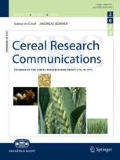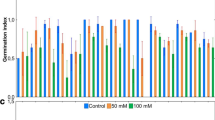Abstract
Salinity limits the oat germination and seedling growth at early growth stages. This study was aimed to determine the morpho-physiological response of 33 (10 commercial and 23 landraces) oat genotypes to four NaCl salinity stresses (0, 30, 60 and 90 mM) under in vitro conditions during seed germination and early seedling stages. The effect of NaCl stress on water uptake, germination ratio, root length, shoot length, root fresh weight, root dry weight, shoot fresh weight, shoot dry weight, ion contents (Na+, K+, Ca and K+/Na+) for both root and shoot and photosynthetic pigments (Chl a, Chl b, Chl a + b and carotenoid) in 33 oat genotypes was investigated in the experiment. The investigated traits were decreased by salt stress from control (0 mM) to 90 mM doses including 18% for water uptake, 54.9% for germination rate, 87.5% for root length, 87% for shoot length, 74.5% for root fresh weight, 38.5% for root dry weight, 79.1% for shoot fresh weight, 62.4% for shoot dry weight, 84.5% for root K+/Na+, 97% for shoot K+/Na+, 62.2% for chl a, 51.6% for chl b and 61.7% for carotenoid. It was found that the oat genotypes showed a wide variation in the cluster analysis based on morpho-physiological traits. According to the principal component biplot analysis, principal components (PC1 and PC2) represented (33.9 and 16.4%, respectively) 50.3% of the total variation among the genotypes under salt stress. TL582 landrace showed greater performance for the investigated traits among oat genotypes for the highest salt tolerance. The investigated traits are important growth indices and physiological parameters to be used as selection criteria to evaluate salt tolerance in oat genotypes. The results of the study determined the registered and local genotypes that can be used as parent lines in breeding programs.
Similar content being viewed by others
References
Akbarimoghaddam H, Galavi M, Ghanbari A, Panjehkeh N (2011) Salinity effects on seed germination and seedling growth of bread wheat cultivars. Trakia Journal of Sciences 9:43–50
Al-Ashkar I, Alderfasi A, El-Hendawy S, Al-Suhaibani N, El-Kafafi S, Seleiman MF (2019) Detecting salt tolerance in doubled haploid wheat lines. Agronomy 9:211
Aliu S, Rusinovci I, Fetahu S, Gashi B, Simeonovska E, Rozman L (2015) The effect of salt stress on the germination of maize (Zea mays L.) seeds and photosynthetic pigments. Acta agric Slov 105:85–94
Aslan D, Aktaş H, Ordu B, Zencirci N (2017) Evaluation of bread wheat and einkorn wheat under in vitro drought stress. The J Anim Plant Sci 27:1974–1983
Bai J, Yan W, Wang Y, Yin Q, Liu J, Wight C, Ma B (2018) Screening oat genotypes for tolerance to salinity and alkalinity. Front Plant Sci 9:1302
Batool M, Bashir MA, Qayyoum MA, Hussain A, Hameed SA, Alghanem SM, Saqib M (2020) Effect of potassium application on the growth and Fe/Zn use efficiency of salt-tolerant and sensitive maize genotypes in response to salinity. Fresenius Environ Bull 29:3778–3789
Bibi Z, Khan NU, Latif A, Khan MJ, Manyuan G, Niu Y, Khan QU, Khan MJ, Khan IU, Shaheen S, Sadozai GU (2016) Salt tolerance in upland cotton genotypes to NaCl salinity at early growth stages. The J Anim Plant Sci 26:766–775
Boczkowska M, Tarczyk E (2013) Genetic diversity among Polish landraces of common oat (Avena sativa L.). Genet Resour Crop Ev 60:2157–2169
Chauhan A, Rajput N, Kumar D, Kumar A, Chaudhary AK (2016) Effect of different salt concentration on seed germination and seedling growth of different varieties of oat (Avena sativa L.). International Journal of Information Research and Review 3:2627–2632
Devi S, Nandwal AS, Arora RN, Kumar N, Sharma SK, Bisht SS, Roy AK, Arya SS, Solanki YPS (2018) Water relations, quantum yield of PS-II, antioxidative enzymes, membrane integrity and ionic contents are indices of salinity stress tolerance in Avena sativa L. International Journal of Natural Sciences Research 1:1–17
Devi S, Phogat DS, Satpal Goyal V (2019) Responses of oat (Avena sativa L.) genotypes under salt stress. International Journal Chemical Studies 7:734–737
Dumlupınar Z, Maral H, Kara R, Dokuyucu T, Akkaya A (2011) Evaluation of Turkish oat landraces based on grain yield, yield components and some quality traits. Turk J Field Crops 16:190–196
Dumlupınar Z, Jellen EN, Bonman JM, Jackson EW (2016) Genetic diversity and crown rust resistance of oat landracesfrom various locations throughout Turkey. Turk J Agric For 40:262–268
Ekmekçi E, Apan M, Kara T (2005) The effect of salinity on plant growth. OMU Journal of Faculty of Agriculture 20:118–125
Fu YB, Peterson GW, Williams D, Richards KW, Fetch JM (2005) Patterns of AFLP variation in a core subset of cultivated hexaploid oat germplasm. Theor Appl Genet 111:530–539
Güngör H, Çıkılı Y, Dumlupınar Z (2017) The effect of salt stress on germination and seedling development of some commercial and landraces of oat genotypes. KSU J Nat Sci 20:263–267
Gungor H, Çikili Y, Dumlupinar Z (2019) Evaluation of morpho-physiological traits of Turkish rice genotypes in response to salt stress under in vitro conditions. The J Anim Plant Sci 29:556–567
Gyawali S, Parkin IAP, Steppuhn H, Buchwaldt M, Adhikari B, Wood R, Wall K, Buchwaldt L, Singh M, Bekkaoui D, Hegedus DD (2019) Seedling, early, vegetative, and adult plant growth of oilseed rapes (Brassica napus L.) under saline stress. Can J Plant Sci 99:927–941
Hussain M, Ahmad S, Hussain S, Lal R, Ul-Allah S, Nawaz A (2018) Rice in saline soils: physiology, biochemistry, genetics, and management. Advances Agronomy 148:231–287
JMP®, Version 15.1. SAS Institute Inc., Cary, NC, 1989–2020
Javed Q, Azeem A, Sun J, Ullah I, Jabran K, Anandkumar A, Prabakaran K, Buttar NA, Du D (2019) Impacts of salt stress on the physiology of plants and opportunity to rewater the stressed plants with diluted water: A Review. Appl Ecol Environ Res 17:12583–12604
Kumar A, Agarwal S, Singh A (2014) Salinity effects the germination and seedling growth in some cultivars of oat (Avena sativa L.). Indian Journal of Advances in Plant Research 1:1–10
Lichtenthaler HK (1987) Chlorophylls and carotenoids: pigments of photosynthetic biometers. Methods Enzymol 148:350–382
Montilla-Bascon G, Sanchez-Martin J, Rispail N, Rubiales D, Mur L, Langdon T, Griffiths I, Howarth C, Prats E (2013) Genetic diversity and population structure among oat cultivars and landraces. Plant Mol Biol Rep 31:1305–1314
Mu Y, Lin J, Mu C, Gao Z (2015) Effects of NaCl stress on the growth and physiological changes in oat (Avena sativa) seedlings. Not Bo Horti Agrobo 43:468–472
Müftüoğlu NM, Türkmen C, Çıkılı Y (2014) Toprak ve Bitkide Verimlilik Analizleri (Yield analysis in Soil and Plant), 2nd edn. Nobel Akademik Yayıncılık, Ankara (978-605-133-895-8)
Narimani T, Toorchi M, Tarinejad AR, Mohammadi SA, Mohammadi H (2020) Physiological and biochemical evaluation of Barley (Hordeum vulgare L.) under salinity stress. J Agric Sci Technol 22:1009–1021
Nawaz M, Khan A, Ashraf MY (2019) Screening mungbean germplasm for salt tolerance using growth indices and physiological parameters. Intl J Agric Biol 22:401–406
Newell MA, Cook D, Tinker NA, Jannink JL (2011) Population structure and linkage disequilibrium in oat (Avena sativa L.): implications for genome-wide association studies. Theor Appl Genet 122:623–632
O’Donoughue LS, Souza E, Tanksley SD, Sorrells ME (1994) Relationships among North-American oat cultivars based on restriction-fragment-length polymorphisms. Crop Sci 34:1251–1258
Oliver RE, Lazo GR, Lutz JD, Rubenfield MJ, Tinker NA, Anderson JM, Wisniewski Morehead NH, Adhikary D, Jellen EN, Maughan PJ, Brown Guedira GL, Chao S, Beattie AD, Carson ML, Rines HW, Obert DE, Michael Bonman J, Jackson EW (2011) Model SNP development for complex genomes based on hexaploid oat using high-throughput 454 sequencing technology. BMC Genomics 12:77
Out Borlu H, Celiktas V, Duzenli S, Hossain A, El Sabagh A (2018) Germination and early seedling growth of five durum wheat cultivars (Triticum durum Desf.) is affected by different levels of salinity. Fresenius Environ Bull 27:7746–7757
Özaktan H, Çiftçi CY, Kaya MD, Uzun S, Uzun O, Akdoğan G (2018) Chloride salts inhibit emergence and seedling growth of chickpea rather than germination. Legume Res 41:60–66
Peterson DM, Wesenberg DM, Burrup DE, Erickson CA (2005) Relationships among agronomic traits and grain composition in oat genotypes grown in different environments. Crop Sci 45:1249–1255
Riaz F, Abbas G, Saqip M, Amjad M, Farooq A, Ahmad S, Naeem MA, Umer M, Khalid MS, Ahmed K, Ahmad N (2020) Comparative effect of salinity on growth, Ionic and physiological attributes of two Quinoa genotypes. Pak J Agric Sci 57:115–122
Tekin A, Aslan E, Herek S, Dokuyucu T, Gezginç H, Tekerek H, Dumlupınar Z, Akkaya A (2017) Molecular characterization of Turkish oat genotypes using simple sequence repeats (SSR) markers. KSÜ Journal of Natural Sciences 20:378–384
Turk M, Alagoz M (2020) Effects of salt stress on seedling growth of some silage maize (Zea mays L.) cultivars. Fresenius Environ Bull 29:1612–1617
TÜİK (2019) Turkish Statistical Institute. http://www.tuik.gov.tr. Access date: 15 September 2019
Ullah MA, Mahmood IA, Sarwar M, Rasheed M (2019) Screening of Oat (Avena sativa) varieties in saline-sodic soil. Am J Biomed Sci & Res 4:104–106
Ul Haq T, Akhtar J, Nawaz S, Ahmad R (2009) Morpho-Physiological response of rice (Oryza sativa L.) varieties to salinity stress. Pak J Bot 41:2943–2956
Umar M, Siddiqui ZS (2018) Physiological performance of sunflower genotypes under combined salt and drought stress environment. Acta Bot Croat 77:36–44
Yan W, Hunt LA, Sheng Q, Szlavnics Z (2000) Cultivar evaluation and mega-environment investigation based on the GGE biplot. Crop Sci 40:597–605
Yan W (2001) GGE biplot – A windows application for graphical analysis of multi-environment trial data and other types of two-way data. Agron J 93:1111–1118
Yepes L, Chelbi N, Vivo J-M, Franco M, Agudelo A, Carvajal M, del Martínez-Ballesta M, C, (2018) Analysis of physiological traits in the response of Chenopodiaceae, Amaranthaceae, and Brassicaceae plants to salinity stress. Plant Physiol Biochem 132:145–155
Funding
This study was supported by the Scientific Research Council of Duzce University (DU BAP Project No: 2016.11.04.454). The authors would like to thank Dr. Khawar Jabran for checking language of the manuscript.
Author information
Authors and Affiliations
Corresponding author
Ethics declarations
Conflict of interest
The authors declare that they have no conflict of interest.
Ethical approval
This article does not contain any studies with human participants or animals performed by any of the authors.
Informed consent
The authors agreed to the publication of the manuscript. All authors read and approved the final manuscript.
Supplementary Information
Below is the link to the electronic supplementary material.
Rights and permissions
About this article
Cite this article
Güngör, H., Çıkılı, Y. & Dumlupınar, Z. Screening of oat varieties and landraces at early vegetative stage under salt stress conditions: Morpho-physiological and PCA biplot analysis. CEREAL RESEARCH COMMUNICATIONS 49, 587–597 (2021). https://doi.org/10.1007/s42976-021-00138-0
Received:
Accepted:
Published:
Issue Date:
DOI: https://doi.org/10.1007/s42976-021-00138-0




